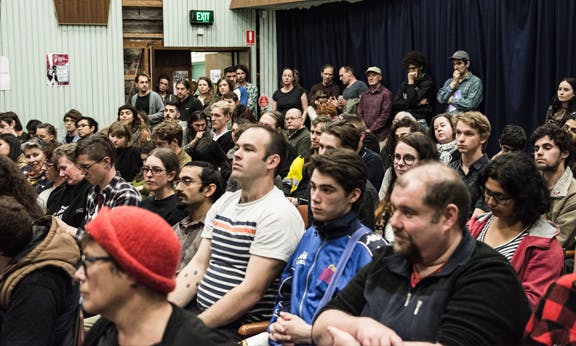Hundreds at Socialist Alternative’s union conference

More than 250 people attended Socialist Alternative’s Union Activism and History Conference, held at the Victorian Trades Hall on Saturday, 15 October.
Union delegates and activists present were drawn from a variety of industries including transport, the public service, logistics, construction, health care and education.
It was a fantastic day of discussion and debate about the history and politics of unionism in Australia as well as the issues confronting the trade union movement today, including what strategies are necessary to rebuild rank and file power.
A favourite session for many was the packed plenary: “Fight back against Coles: stories from inside a warehouse strike”. National Union of Workers delegates and strike leaders Curtly Tuala and Ryan Laws spoke about the dramatic three-day Polar Fresh warehouse strike that crippled the Coles supply chain for more than a week in July.
In a period characterised by low union density and strike rates, high levels of job insecurity and stagnating wage growth, it was refreshing to hear how rank and file activists organised their shed to strike successfully for a significant pay rise and job security.
Other program highlights included: Denis Evans, long-time militant and 3CR presenter, an organiser with the Transport Workers Union in the ’80s. He spoke about the brief tumultuous years when a reform leadership group rebuilt a militant rank and file union that posed a challenge to the Prices and Incomes Accord.
Teachers and others came to hear from Melbourne teacher Cameron Rowe and Chicago teacher Caitlin Sheehan on “How to organise and win – a lesson from Chicago teachers”.
Health worker, delegate and recent strike participant Madilyn Gorman presented “When women workers revolt: the 1986 nurses’ strike”. She told the story of this important example of militancy, fighting sexist stereotypes and challenging the ACTU.
The day concluded with conference participants taking a solidarity photo and passing the hat around for the sacked CUB workers’ fighting fund.
Organisers were pleased with the conference turnout, which was the largest since the conference began three years earlier. Its success has quickly cemented the Union Activism and History Conference’s place on Melbourne’s industrial calendar. While details are yet to be confirmed, the conference will be held again in 2017.